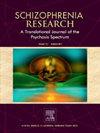Hippocampal subfield activity in schizophrenia: Effects of the disease course
IF 3.5
2区 医学
Q1 PSYCHIATRY
引用次数: 0
Abstract
Alterations in hippocampal structure and function are established in schizophrenia. However, the specific patterns of hippocampal activity along the schizophrenia course remain unknown. Eighty-five study participants [34 schizophrenia probands (SZ), 32 first-degree relatives (REL), 19 healthy controls (HC)] underwent 3Tesla ultra-high resolution brain MRI (Vascular Space Occupancy); relative cerebral blood volume (rCBV)—an index of regional activity—was estimated across hippocampal subfields: dentate gyrus (DG), CA3, CA1, and subiculum (SUB). To examine effects of the schizophrenia course, SZ were stratified into SZ-Early (≤7 yrs. from psychosis onset), SZ-Mid-Course (8-14 yrs) and SZ-Advanced (≥15 yrs). REL were grouped into those with (REL![]() P) and without (REL-NP) psychosis spectrum disorders. Medication effects were examined by contrasting SZ on- vs. off-antipsychotics. No hippocampal rCBV differences emerged in SZ vs. HC or in SZ-on vs. SZ-off antipsychotic medications. However, among the SZ course groups, SZ-Early showed elevated rCBV in CA3, CA1 and DG compared to SZ-Advanced and HC (p = .004–032). Illness duration-based cross-sectional “trajectories” demonstrated elevated hippocampal rCBV within the initial 7 yrs., followed by an intermediary plateau (8-20 yrs), and a subsequent decline in advanced (20+ yrs) SZ. Among biological relatives of SZ, REL-P vs. HC showed reduced rCBV in SUB, CA1 and DG (p = .021–0.046). Our findings demonstrate differential patterns of hippocampal rCBV along the schizophrenia course. Regional hippocampal activity may serve as a granular biomarker sensitive to the effects of the schizophrenia course and, via future work, inform SZ stage-specific interventions: e.g., reducing hippocampal hyperactivity in early-course SZ vs. enhancing this same circuit's function in advanced stages of SZ.
P) and without (REL-NP) psychosis spectrum disorders. Medication effects were examined by contrasting SZ on- vs. off-antipsychotics. No hippocampal rCBV differences emerged in SZ vs. HC or in SZ-on vs. SZ-off antipsychotic medications. However, among the SZ course groups, SZ-Early showed elevated rCBV in CA3, CA1 and DG compared to SZ-Advanced and HC (p = .004–032). Illness duration-based cross-sectional “trajectories” demonstrated elevated hippocampal rCBV within the initial 7 yrs., followed by an intermediary plateau (8-20 yrs), and a subsequent decline in advanced (20+ yrs) SZ. Among biological relatives of SZ, REL-P vs. HC showed reduced rCBV in SUB, CA1 and DG (p = .021–0.046). Our findings demonstrate differential patterns of hippocampal rCBV along the schizophrenia course. Regional hippocampal activity may serve as a granular biomarker sensitive to the effects of the schizophrenia course and, via future work, inform SZ stage-specific interventions: e.g., reducing hippocampal hyperactivity in early-course SZ vs. enhancing this same circuit's function in advanced stages of SZ.
精神分裂症患者海马亚区活动:病程的影响
海马体结构和功能的改变是在精神分裂症中建立的。然而,海马体活动在精神分裂症病程中的具体模式仍然未知。85名研究对象[34名精神分裂症先证者(SZ), 32名一级亲属(REL), 19名健康对照(HC)]接受了3Tesla超高分辨率脑MRI(血管空间占用)检查;相对脑血容量(rCBV) -区域活动指数-在海马亚区:齿状回(DG), CA3, CA1和下丘(SUB)进行估计。为了检查精神分裂症病程的影响,将SZ分为SZ-早期(≤7年)。sz -中期(8-14年)和sz -晚期(≥15年)。将REL分为有(RELP)和无(REL- np)精神病谱系障碍两组。通过对比SZ在抗精神病药物上和在非抗精神病药物上的用药效果来检验用药效果。在抗精神病药物中,SZ与HC或SZ-on与SZ-off的海马rCBV没有差异。然而,在SZ病程组中,与SZ- advanced和HC相比,SZ- early显示CA3、CA1和DG的rCBV升高(p = 0.004 - 032)。基于病程的横断面“轨迹”显示在最初7年内海马rCBV升高。,随后是一个中间平台期(8-20年),随后在SZ晚期(20+年)下降。在SZ的生物学亲属中,REL-P与HC相比,SUB、CA1和DG的rCBV降低(p = 0.021 - 0.046)。我们的研究结果表明,在精神分裂症病程中,海马rCBV的不同模式。海马区域活动可以作为对精神分裂症病程影响敏感的颗粒生物标志物,并通过未来的工作,为SZ阶段特定的干预提供信息:例如,减少早期SZ的海马体过度活跃,增强SZ晚期的相同回路功能。
本文章由计算机程序翻译,如有差异,请以英文原文为准。
求助全文
约1分钟内获得全文
求助全文
来源期刊

Schizophrenia Research
医学-精神病学
CiteScore
7.50
自引率
8.90%
发文量
429
审稿时长
10.2 weeks
期刊介绍:
As official journal of the Schizophrenia International Research Society (SIRS) Schizophrenia Research is THE journal of choice for international researchers and clinicians to share their work with the global schizophrenia research community. More than 6000 institutes have online or print (or both) access to this journal - the largest specialist journal in the field, with the largest readership!
Schizophrenia Research''s time to first decision is as fast as 6 weeks and its publishing speed is as fast as 4 weeks until online publication (corrected proof/Article in Press) after acceptance and 14 weeks from acceptance until publication in a printed issue.
The journal publishes novel papers that really contribute to understanding the biology and treatment of schizophrenic disorders; Schizophrenia Research brings together biological, clinical and psychological research in order to stimulate the synthesis of findings from all disciplines involved in improving patient outcomes in schizophrenia.
 求助内容:
求助内容: 应助结果提醒方式:
应助结果提醒方式:


